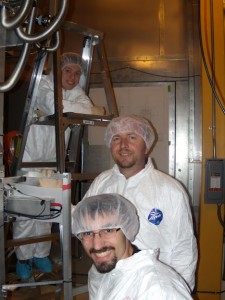Unraveling the mysteries of the universe: The search for dark matter
 Working half a mile underground in an old Minnesota mine, two engineering students and their physics professor described the subterranean lab as pretty typical … except for the occasional bat flying overhead.
Working half a mile underground in an old Minnesota mine, two engineering students and their physics professor described the subterranean lab as pretty typical … except for the occasional bat flying overhead.
Messiah College Physics Professor Abaz Kryemadhi and two engineering students, Joel Love ‘14 and Nick Martin ‘14, were awarded a Department of Energy Visiting Faculty Program grant to spend 10 weeks at Fermi National Accelerator Laboratory in Chicago. There they worked with the Cryogenic Dark Matter Search (CDMS) experiment which is located half a mile underground in an old mine in Soudan, MN. The Messiah College team worked on simulation and detector design for a new generation detector called SuperCDMS.
Student Joel Love describes getting into the mine, “We road an elevator a half-mile down a slightly inclined shaft. The darkness and the incline threw our sense of balance pretty badly, and we bumped into each other the whole way down.” Other than unusual transport to the lab, Love says, the research facility was hardly distinguishable from any other lab he’s seen.
Within the lab, the Messiah researchers were part of a contingency studying dark matter. Kryemadhi explains, dark matter is a form of exotic matter which interacts primarily through gravity with “ordinary” matter (which makes planets, stars and us). Dark matter is about five times more abundant than regular matter but because of its weak interaction, it has evaded direct detection. Evidence for its existence comes from indirect sources.
It is believed that dark matter is in a form of exotic particles such as Weakly Interacting Massive Particles (WIMPs), which on very rare occasions would hit atoms of ordinary matter, and the recoil energy of this collision could be detected as a fingerprint for the WIMPs. In order to sort out which recoil was from dark matter and which one was from ordinary matter, the experiment is located deep underground to escape the high flux of cosmic rays on the surface. Also, crystals where collisions happen are kept at a temperature colder than the coldest spot in the universe. 
Kryemadhi provides this example: for instance, our solar system is revolving around the Milky Way galaxy faster than if it were made of ordinary matter because of the gravity of this dark matter present in the Milky Way. Without dark matter, the rotation of our solar system would be unstable and Earth would have been kicked out of the galaxy.
Besides the opportunity to conduct fascinating research in a unique location, Love is also grateful for the experience because he now feels more confident about his ability to apply to research-oriented graduate programs.




